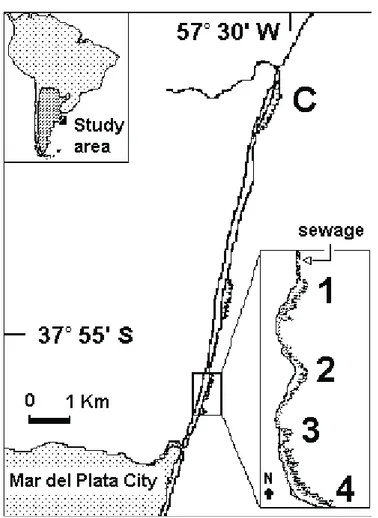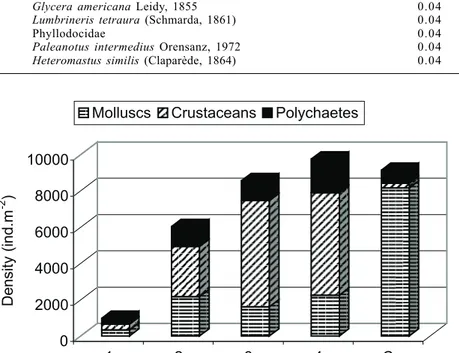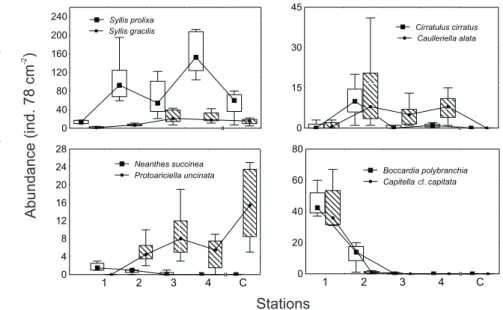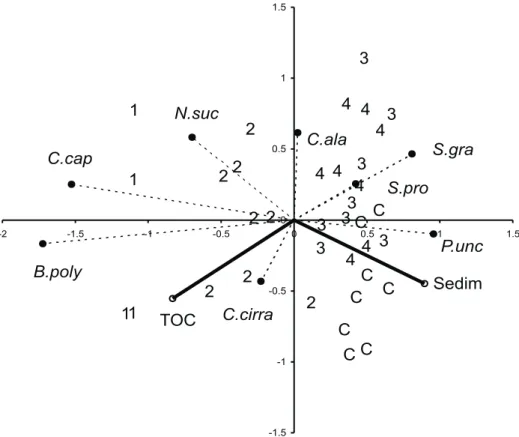SEWAGE IMPACT ON THE COMPOSITION AND DISTRIBUTION OF
POLYCHAETA ASSOCIATED TO INTERTIDAL MUSSEL BEDS OF THE
MAR DEL PLATA ROCKY SHORE, ARGENTINA
Rodolfo Elías
1María Silvia Rivero
1Eduardo Alberto Vallarino
1ABSTRACT
The polychaete composition and distribution within mussel beds were studied in order to assess organic pollution due to domestic sewage in a rocky shore of Mar del Plata (Argentina) during 1997. Four stations and a control site were randomly sampled around the local effluent. Quantitative data on polychaetes, as well as sediment accumulated among mussels and its organic carbon content were measured. Polychaete distribution patterns are related to the organic matter gradient, being Capitella
cf. capitata, Neanthes succinea (Frey & Leuckart, 1847) and Boccardia polybranchia (Haswell, 1885) the dominant indicator species close to the effluent. At medial distances, the cirratulids
Caulleriella alata (Southern, 1914) and Cirratulus cirratus (Müller, 1776) are very important in abundance. The syllids Syllis prolixa Ehlers, 1901 and S. gracilis Grube, 1840 are distributed along the study area, but dominate at the medial stations and at the control site. The orbiniid Protoariciella uncinata Hartmann-Schröder, 1962 is subdominant at the control station.
KEYWORDS. Polychaeta, intertidal, mussel beds, sewage, Southwestern Atlantic.
INTRODUCTION
Biological communities have been seen as effective tools for assessing sewage
pollution. Macrobenthic animals are easy to monitor, because they can be sampled
quantitatively and also respond to man-made disturbance (O
TWAYet al
., 1996). Organic
enrichment of sediments due to sewage may result in a series of non-linear changes in
the abundance, biomass and diversity of benthic organisms, in both spatial and temporal
patterns (P
EARSON& R
OSENBERG, 1978). Polychaetes are one of the most useful marine
organisms to detect pollution because they live at the water-sediment interface. This
layer is biologically reactive and chemically active (R
HOADS& B
OYER, 1982). Polychaetes
have been used in bioassays, to monitor toxic compounds, and as pollution indicators,
from community or populational levels to species level (P
OCKLINGTON& W
ELLS, 1992;
R
EISH& G
ERLINGER, 1997). The presence or absence of some indicator species or even
families are currently known as pollution indicators, in particular the presence of
Capitella
310 ELÍAS, RIVERO & VALLARINO
capitata
(Fabricius, 1780) or some spionids (T
SUTSUMI, 1990), or the absence of the
genus
Lumbrineris
Blainville, 1828 (R
YGGS, 1985).
In the southwestern Atlantic shore, sewage is discharged into the shallow waters
or intertidal areas, like in the Mar del Plata (38°S; 57°W), Argentina. The city (with about
550,000 inhabitants) needs a way to evaluate the extent and degree of this impact because
it is the major seaside resort of the country, receiving more than 2,000,000 people during
the summer. The intertidal zone in the Mar del Plata area is constituted by extense sandy
beaches (without macrofauna) and rocky shores (quartzitic outcrops and platforms of
caliche). Arround the sewage effluent, the intertidal zone comprises abrasion platforms
inhabited by mussel beds made up by the mytilid
Brachidontes rodriguezii
(Orbigny,
1846). The community structure of these epilithic mussel beds has been successfully
used to detect the environmental impact due to domestic sewage (L
ÓPEZG
APPAet al
.,
1990). The monitoring using community-level information is expensive in terms of
men-hours needed to identify and count all organisms living in the mussel community. The
study of the mussel-associated flora and fauna could be suitable for assessing organic
enrichment due to domestic sewage in the Argentine coast (L
ÓPEZG
APPAet al
., 1993).
The mussel matrix creates sedimentary microhabitats that are occupied by small
invertebrates, including several polychaetes (P
ENCHASZADEH, 1973; T
SUCHIYA& N
ISHIHIRA,
1985; J
ACOBI, 1987; G
ÜNTHER, 1996; S
CELZOet al
., 1996; S
VANE& S
ETYOBUDIANDI, 1996;
R
AGNARSSON& R
AFFAELLI, 1999). However, no quantitative data about polychaete pattern
are available from the southwestern Atlantic shore.
In order to assess the sewage impact on this hard-bottom intertidal area, a spatial
study of the polychaete species associated with mussel beds was conducted.
MATERIAL AND METHODS
The sampling area is an open coast exposed to a longshore littoral current (South to North) and autumn-winter storms. Extensive sandy beaches alternate with quartzitic outcrops and abrasion platforms. Around the sewage effluent, an abrasion platform is exposed to low tides, being azoic in the North (except for a few opportunistic algae), and covered by a mytilid community in the South (the sampling area). These platforms are hard substrates of caliche (consolidate loess), characterized by an irregular and gradual slope (almost horizontal). Grooves lying perpendicular to the shoreline are common. Semidiurnal tides vary between 0.61 and 0.91 m (ISLA & FERRANTE, 1997). Energy waves are high (mean height of 0.91 m) reaching a maximum of 2.3 m during storms (LANFREDIet al., 1992). The
coastal area of Mar del Plata is characterized by the presence of Continental Shelf Waters, with seawater temperature ranging from 8 to 21º C, and salinity from 33.5 to 33.8 psu (GUERRERO & PIOLA, 1997).
Four locations, from 50 m (station 1) up to 700 m (station 4) south of the effluent, were sampled during November 1997 (fig. 1). Sampling was performed in each station at two levels, superior (exposed in neap tides) and inferior (only exposed in spring tides), except for station 1 (the closest to the effluent) due to the absence of the inferior level. At each level, four sampling units were randomly obtained with a 78 cm2 corer (diameter: 10 cm). A control site (station C) was also sampled in the Santa Elena Formation (also an abrasion platform) placed 9 km north of the effluent. Each sampling unit was sieved (1 mm), and the associate polychaetes living on and among mussels were studied. Polychaete identification follows FAUCHALD (1977) and specific papers. Sediments
accumulated among mussels were retained for total weight in each sampling unit, and their total organic Carbon content (%) was determined from subsamples (WALKLEY & BLACK, 1965).
in which station is the fixed factor and the abundance of polychaetes the categorical predictor variable. Differences in total organic Carbon and sediment among mussels were tested by an one-way ANOVA. Whenever a difference was established, a post-hoc SNK test was performed to the appropriate alpha level. The relationship between the biological and the environmental variables was analyzed with Redundancy analysis (RDA), and a simple Regression analysis was performed for each polychaete species and total organic Carbon (JONGMANet al., 1995). The material is deposited in the laboratory of Bioindicadores Bentónicos, Departamento de Ciencias Marinas, Universidade Nacional de Mar del Plata.
RESULTS
Sediments accumulated among mussels increased from the effluent to the control
station (fig. 2). Total organic Carbon was high at the stations 1 and 2 (from 50 to 230 m), but
low at the stations 3 and 4 (>450 m) and at the control station (fig. 3). Differences in both
parameters were highly significant (p<0.01) between stations 1-2 and the other stations.
312 ELÍAS, RIVERO & VALLARINO
Fig. 2. Mean (± sd) of sediments among mussels (kg.m-2
) in each sampling station.
Fig. 3. Mean (± sd) of total organic Carbon (%) in each sampling station.
A total of 5,098 individuals belonging to 18 species were identified (tab. I).
Polychaete dominance ranged from 7.7 to 37.7 % of the community, these extreme values
corresponding respectively to station C (control) and station 1 (the closest to the effluent)
(fig. 4).
T
o
tal organic Carbon(%)
Stations
2.8
2.4
2.0
1.6
1.2
0.8
0.4
0.0
1 2 3 4 C
Sediment retained by mussels (kg.m
-2)
Station
100
80
60
40
20
A first one-way ANOVA was performed to test differences between tidal levels,
superior and inferior, and proved to be not significant. Sampling units were therefore
pooled for a two-way ANOVA considering stations and polychaetes as factors. The
Fig. 4. Mean density and proportion of macroorganisms in the intertidal area affected by domestic sewage effluent from the city of Mar del Plata (38ºS; 57ºW). Organic gradient decreases from Station 1 to 4. Station C (control) is situated 9 km north.
Table I. Polychaetes and their dominance (%) in the intertidal mussel beds of the mytilid Brachidontes rodriguezii community in the Mar del Plata shore, Argentina, during 1997. The marked species (9) present normal distribution before transformation and were used in the analysis.
65.20 12.00 5.88 5.62 4.28 3.57 2.03 0.65 0.28 0.12 0.06 0.06 0.04 0.04 0.04 0.04 0.04 0.04
Syllis prolixa Ehlers, 1901
Syllis gracilis Grübe, 1840
Protoariciella uncinata Hartmann-Schröder, 1962
Boccardia polybranchia (Haswell, 1885)
Caulleriella alata (Southern, 1914)
Capitella cf. capitata
Cirratulus cirratus (Müller, 1776)
Boccardia chilensis Hartman, 1940
Neanthes succinea (Frey & Leuckart, 1847)
Syllis sp.1
Spionidae unidentified
Dodecaceria concharum Oested, 1843
Syllis sp.2
Glycera americana Leidy, 1855
Lumbrineris tetraura (Schmarda, 1861) Phyllodocidae
Paleanotus intermedius Orensanz, 1972
Heteromastus similis (Claparède, 1864)
Dominance (%)
0
2000
4000
6000
8000
10000
Dens
it
y
(ind.
m
-2
)
1
2
3
4
C
Molluscs
Crustaceans
Polychaetes
9 9 9 9 9 9 9
314 ELÍAS, RIVERO & VALLARINO
results showed that differences between both stations and polychaetes were significant,
as well as differences due to interactions (tab. II).
Interactions between stations and polychaete distribution patterns (fig. 5) show
the different behavior according to distance from effluent.
Capitella
cf
.
capitata
,
Neanthes succinea
and
Boccardia polybranchia
were dominant near the outfall (station
1, and in minor degree in station 2). These species had positive and significant (p<0.05)
correlation coefficients for total organic Carbon (r
2=0.4312, 0.3905, and 0.1412,
respectively). Dominance of syllids (
Syllis prolixa
and
S. gracilis
) was inversely correlated
to the distance from the effluent, and only diminished by the presence of a great abundance
Table II. Two-way analysis of variance (ANOVA) considering station as fixed factor and abundance of polychaetes as categorical predictor variable. Polychaete species considered: Neanthes succinea,
Boccardia polybranchia, Capitella cf. capitata, Cirratulus cirratus, Caulleriella alata, Syllis prolixa,
Syllis gracilis and Protoariciella uncinata (*p<0.05). MS Effect
df Effect df Error MS Error F p-level
Station Polychaetes Interaction 4 7 2 8 4.61122 19.12289 3.36003 3 1 217 217 0.203576 0.155417 0.155417 22.6511 123.042 21.6194 0.000000* 0.000000* 0.000000* 40 80 120 160 200
240 Syllis prolixa
15 30 45 Cirratulus cirratus 0 4 8 12 16 20 24 28 Neanthes succinea 0 20 40 60 80 Boccardia polybranchia
A
bundance
(ind.
78
cm
)
-2Stations
cf.of
Protoariciella uncinata
in the control station (C). The former species had negative
and significant (p<0.05) correlation coefficients for total organic Carbon (r
2= -0.1566, -0.2606,
and -0.3447 respectively). At medial distances the cirratulids
Caulleriella alata
and
Cirratulus
cirratus
were sub dominant, with low and non-significant correlation coefficients.
Redundancy analysis (fig. 6) showed the existence of two major and opposite
gradients along axis I, one of increasing amount of total organic Carbon from the control
site to the outfall, and other of increasing sediment accumulated among mussels, with an
opposite trend. The closest stations to the effluent were highly related to positive values
of the first gradient, as well as the species
C. cf
.
capitata
,
N. succinea
and
B. polybranchia
,
while the control station (C) was highly related to the negatives values, associated to
P.
uncinata
and syllids. Axis I explained 97.2 % of the total variance, and represents the
organic enrichment gradient. Axis II explained 2.8 % of the variance and is apparently
related to species richness, which is high at medial stations (positive values).
Fig. 6. Redundancy analysis on sampling units, species and environmental variables in the intertidal mussel beds exposed to sewage discharge from the city of Mar del Plata (Sedim, sediment accumulated among mussels; TOC, total organic Carbon; C. cap, Capitella cf. capitata; C. cirra, Cirratulus cirratus; N. suc, Neanthes succinea; B. poly, Boccardia polybranchia; C. ala, Caulleriella alata; S. pro, Syllis prolixa; S. gra, Syllis gracilis; P. unc, Protoariciella uncinata).
N.suc
S.pro
S.gra
B.poly
C.cirra
C.ala
C.cap
P.unc
Sedim
TOC
1
11
1
2 2
2
2
2
2
2
2
3
3
3
3
3 3
3
3
4
4
4
4
4
4
4
4
C
C
C
C
C
C
C
C
-1.5 -1 -0.5 0 0.5 1 1.5
316 ELÍAS, RIVERO & VALLARINO
DISCUSSION
Spionid and capitellid polychaetes in general, and the
Capitella
complex in
particular, have largely been used as classical indicators of organically enriched sediments
(R
EISH, 1972; T
SUTSUMI, 1990; P
OCKLINGTON& W
ELLS, 1992). In Denmark, the dominance
of
C. capitata
and
Polydora ciliata
Webster, 1879 among
Mytilus edulis
L., 1758 banks
was related to the local hydrodynamics, affecting sedimentation or increasing faeces
and pseudofaeces of mussels (S
VANE& S
ETYOBUDIANDI, 1996). In the intertidal abrasion
platform around Mar del Plata sewage effluent, the distribution pattern of
C. cf. capitata
is clearly related to the gradient of organic pollution. The same can be stated for the
dominant spionid
B. polybranchia
in the station near the effluent. The use of some
spionids (
Polydora ciliata
and other congeneric species and other genera) also indicates
sediments organically enriched (P
EARSON& R
OSENBERG, 1978). In another southern
abrasion platform affected by sewage, L
ÓPEZG
APPAet al
. (1990) found high densities of
Boccardia
sp. (about 500,000 ind.m
-2) associated to sand banks and also among
Brachidontes
Swainson, 1840 beds.
Boccardia proboscidea
Hartman, 1940 was found
primarily in large abundance in the intertidal zone of an outfall area in California, USA
(D
ORSEYet al
., 1983) and also in an Australian sewage (D
ORSEY, 1982).
The cirratulids
Cirratulus cirratus
and
Caulleriella alata
are present at medial
stations. Some cirratulids were also mentioned as indicators of organically enriched
sediments, like
Cirriformia
spp. associated to
Capitella capitata
,
Scolelepis
Blainville,
1828 or
Polydora
Bosc, 1802, in or near polluted areas (P
EARSON& R
OSENBERG, 1978).
Species of the genus
Tharyx
Webster & Benedict, 1887 may be extremely abundant in
polluted areas (F
AUCHALD& J
UMARS, 1979; D
ORSEYet al
., 1983). Around the effluent of
domestic sewage in the northwest of Mediterranean Sea,
C. cirratus
was found in
association to subtidal mytilid beds, being considered as tolerant to organic pollution
(B
ITAR, 1982). No records of great abundances of cirratulids from the southern mytilid
beds were reported before, suggesting that these two species could indicate an
opportunist enrichment.
Neanthes succinea
, formely mentioned for mixohaline waters (O
RENSANZ&
E
STIVARIZ, 1971), was cited as associated to
Brachidontes rodriguezii
community in
vertical substrates (S
CELZOet al
., 1996). Although
Neanthes
Linnaeus, 1758 species
have been found in or around organically polluted zones (P
EARSON& R
OSENBERG, 1978),
this is the first mention for
N. succinea
in the SW Atlantic shore in relation to an organic
gradient.
Syllids are typical inhabitants of this intertidal community (O
LIVIERet al
., 1966;
P
ENCHASZADEH, 1973), being indicators of the high and mid eulittoral in vertical substrates
(S
CELZOet al
., 1996). However, in abrasion platforms (corresponding to the low eulitoral)
affected by sewage, their abundance and dominance reach high values at medial distances
from the effluent, but show a negative relationship with the organic matter. The most
common species is
Syllis prolixa,
followed by
S. gracilis
.
The two gradients observed in the Redundancy analysis from the outfall could
be synthesized in only one, the amount of organic matter, because the sediments
accumulated among mussels in a density-dependent variable are related to the population
dynamics of the mytilids. The density of
Brachidontes rodriguezii
increases from the
outfall to the control site, as well as the presence of juveniles (V
ALLARINOet al
., 2002).
This phenomenon produces the matrix that traps the sediments (G
OSLING, 1992). As a
result of this increasing sewage impact, mytilid density decreases towards the effluent,
resulting in a decrease of trapped sediments.
This is the first comprehensive and quantitative study of the polychaetes
associated to mussel beds in this part of the southwestern Atlantic shore. Although the
data are limited to the spatial scale, other results show that this trend is also present at
the time scale, in both the short-term and the long-term period. The present study confirms
that polychaetes are useful tool to assess sewage impact in the hard-bottom rocky
shores of the southwestern Atlantic.
Acknowledgements. To Dr. V. Radashevsky (Centro de Estudos do Mar, UFPR, Brazil) for identification of spionids. Dra. C. Bremec (CONICET, INIDEP) also contributed to polychaete identification. To Obras Sanitarias Sociedad de Estado (OSSE) for partial funding to the project. Dr. O. Iribarne (UNMdP, Argentina) and Dr. P. Lana (UFPR) for valuable comments, which improved the manuscript, as well as other anonymous reviewer. Lic. L. Sousa revised the english version.
REFERENCES
BITAR, G. 1982. Influence d’un grand émisaire urbain sur la distribution du zoobenthos de substrate dur dans la région de Marseille (Mediterranée Nord-occidentale). Tethys, Paris, 10(3):200-210. DORSEY, J. H. 1982. Intertidal community offshore from the Werribee sewage-treatment farm: an
opportunistic infaunal assemblage. Aust. J. mar. Freshwat. Res., Sydney, 33:45-54. DORSEY, J. H.; GREEN, K. D. & ROWE, R. C. 1983. Effects of sewage disposal on the polychaetous
Annelids at San Clemente Island, California. In: SOULE, D. F. & WALSH, D. eds. Waste disposal
in the oceans. Minimizing impact, maximizing benefits. Los Angeles, University of Southern California. c. 13, p.209-233.
ELÍAS, R.; VALLARINO, E. A. & BREMEC, C. S. 2000. Protoariciella uncinata Hartmann-Schröeder, 1962 (Polychaeta, Orbiniidae): a new record for intertidal mussel beds of the southwestern Atlantic shore affected by sewage effluents. Revta Biol. mar. Oceanogr., Valparaiso, 35(2):181-184. FAUCHALD, K. 1977. The polychaete worms. Definitions and keys to orders, families and genera. Nat.
Hist. Mus. Los Angeles County Allan Hancock Found., Science Series, Los Angeles, 28:1-188.
FAUCHALD, K. & JUMARS, P. A. 1979. The diet of worms: a study of polychaetes feeding guilds. Oceanogr. Mar. Biol. Ann. Rev., Aberdeen, 17:193-284.
GOSLING, E. 1992. The mussel Mytilus: ecology, physiology, genetics and culture. Amsterdam, Elsevier Science Publ. 588p.
GUERRERO, R. A. & PIOLA, A. R. 1997. Masas de agua en la plataforma continental. In: BOSCHI, E. E. ed. El mar Argentino y sus recursos pesqueros 1. Mar del Plata, Instituto Nacional de Investigación y Desarrollo Pesquero. p.107-118.
GÜNTHER, C. P. 1996. Development of small Mytilus beds and its effects on resident intertidal
macrofauna. P.S.Z.N.I. Mar. Ecol., Napoles, 17:117-130.
HARTMANN-SCHRÖDER, G. 1962a. Zweiter beitrag zur Polychaetenfauna von Peru. Kieler Meeresforsch.,
Kiel, 18:109-147.
___. 1962b. Die Polychaeten des Eulittorals. Zur kenntnis des Eulittorals der Chilenischen Pazifikkuste und der Argentinischen Kust Sudpatagoniens unter besonderer Berucksichtigung der Polychaeten und Ostracoden. Mitt. hamb. zool. Mus. Inst., Hamburg, 60(Suppl.):57-167. ISLA, F. I. & FERRANTE, A. 1997. Corrientes. In: ILSA, F. I. ed. Estudio del sector de plataforma
318 ELÍAS, RIVERO & VALLARINO
Exactas y Naturales. p.63-116.
JACOBI, C. M. 1987. The invertebrate fauna associated with intertidal beds of the brown mussel Perna perna (L.) from Santos, Brazil. Stud. Neotrop. Fauna Environ., Lisse, 22:57-72.
JONGMAN, R. H. G.; TER BRAAK, C. J. F. et al. 1995. Data analysis in community and landscape ecology. Cambridge, Cambridge University. 194p.
LANFREDI, N. W.; POUSA, J. L. et al. 1992. Wave-power potential along the coast of the Province of Buenos Aires, Argentina. Energy, Washington, 17:997-1006.
LÓPEZ GAPPA, J. J.; TABLADO, A. & MAGALDI, N. H. 1990. Influence of sewage pollution on a rocky intertidal community dominated by the mytilid Brachydontes rodriguezii. Mar. Ecol. Progr. Ser., Oldendorf, 63:163-175.
___. 1993. Seasonal changes in an intertidal community affected by sewage pollution. Environ. Pollut., Oxford, 82:157-165.
OLIVIER, S. R.; ESCOFET, A. et al. 1966. Contribución al conocimiento de las comunidades bénticas de
Mar del Plata. I. El litoral rocoso entre Playa Grande y Playa Chica. An. Comn Invest. Cient. Prov. B. Aires, Buenos Aires, 7:185-206.
ORENSANZ, J. M. & ESTIVARIZ, M. C. 1971. Los anélidos poliquetos de aguas salobres de la Provincia de Buenos Aires. Revta Mus. La Plata, Zool., La Plata, 11(98):95-114.
OTWAY, N. M.; GRAY, C. A. et al. 1996. Assessing the impacts of deepwater outfalls on spatially- and temporally-variable marine communities. Mar. Environ. Res., Oxford, 41:45-71.
PEARSON, T. H. & ROSENBERG, R. 1978. Macrobenthic succession in relation to organic enrichment and pollution of the marine environment. Oceanogr. Mar. Biol. Ann. Rev., Aberdeen, 16:229-311. PENCHASZADEH, P. 1973. Ecología de la comunidad del mejillín (Brachidontes rodriguezii, D’Orb.) en el mediolitoral rocoso de Mar del Plata (Argentina): el proceso de recolonización. Physis, Serie A, Buenos Aires, 32(84):51-64.
POCKLINGTON, P. & WELLS, P. G. 1992. Polychaetes. Key taxa for marine environmental quality
monitoring. Mar. Pollut. Bull., Oxford, 24:593-598.
RAGNARSSON, S. A. & RAFAELLI, D. 1999. Effects of the mussel Mytilus edulis L. on the invertebrate
fauna of sediments. J. exp. Mar. Biol. Ecol., Amsterdam, 241:31-43.
REISH, D. J. 1972. The use of marine invertebrates as indicators of varying degrees of marine
pollution. In: RUIVO, M. ed. Marine Pollution and Sea Life. London, Fishing News Books. p.203-207.
REISH, D. J. & GERLINGER, T. V. 1997. A review of the toxicological studies with polychaetous annelids. Bull. mar. Sci., Miami, 60:584-607.
RHOADS, D. C. & BOYER, L. F. 1982. The effects of marine benthos on physical properties of sediments. A successional perspective. In: MCCALL, P. L. & TEVESZ, M. J. S. eds.
Animal-sediment relations. Yale, Plenum. c. 1, p.3-52.
RYGGS, B. 1985. Distribution of species along pollution-induced diversity gradients in benthic
communities in Norwegian Fjords. Mar. Pollut. Bull., Oxford, 16:469-474.
SCELZO, M. A.; ELÍAS, R. et al. 1996. Variación estacional de la estructura comunitaria del bivalvo
intermareal Brachidontes rodriguezii (D’Orbigny, 1846) en sustratos artificiales (Mar del Plata, Argentina). Nerítica, Curitiba, 10:87-102.
SVANE, I. & SETYOBUDIANDI, I. 1996. Diversity of associated fauna in beds of the blue mussel Mytilus edulis L.: effects of location, patches size, and position within a patch. Ophelia, Helsingor, 45:39-53.
TSUCHIYA, M. & NISHIHIRA, M. 1985. Islands of Mytilus as a habitat for small intertidal animals: effect
of island size on community structure. Mar. Ecol. Progr. Ser., Oldendorf, 25:71-81.
TSUTSUMI, H. 1990. Population persistence of Capitella sp. (Polychaeta; Capitellidae) on a mud flat
subject to environmental disturbance by organic enrichment. Mar. Ecol. Progr. Ser., Oldendorf, 63:147-156.
VALLARINO, E. A.; RIVERO, M. S. et al. 2002. The community-level response to sewage impact in intertidal mussel beds of the Southwestern Atlantic and the use of the Shannon index to assess pollution. Revta Biol. mar. Oceanogr., Valparaíso, 37(1):25-33.
WALKLEY, A. & BLACK, C. A. 1965. Organic carbon. In: BLACK, C. A. ed. Method of soils analysis.
Madison, American Society of Agronomy. c. 4, p.1372-1375.




